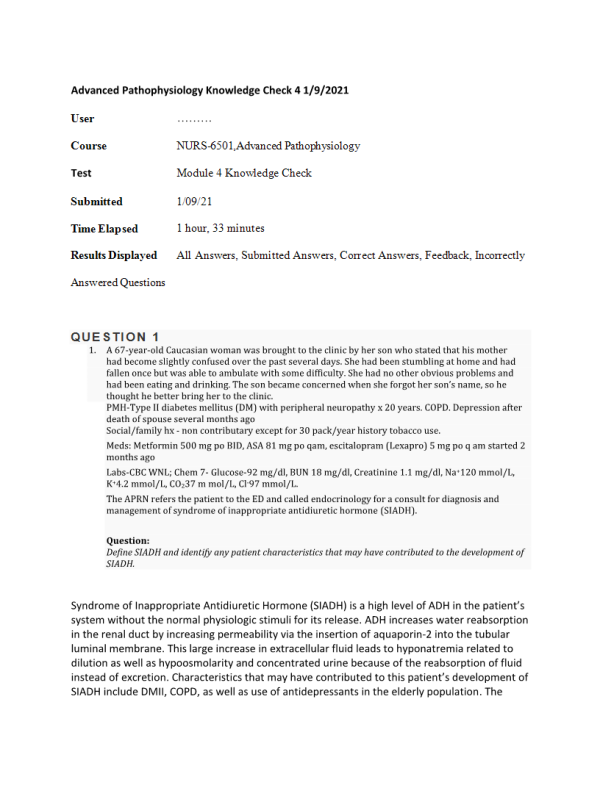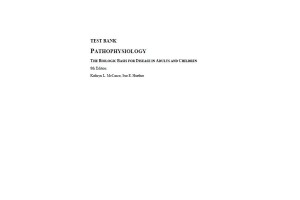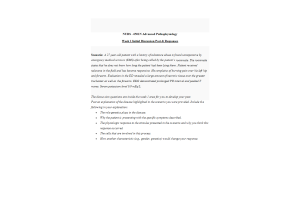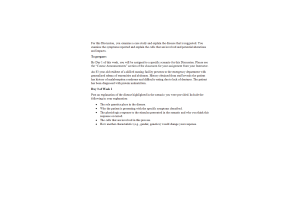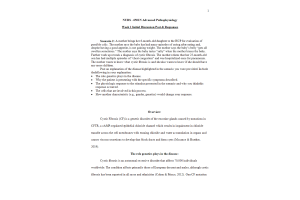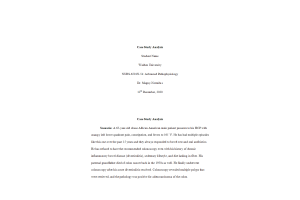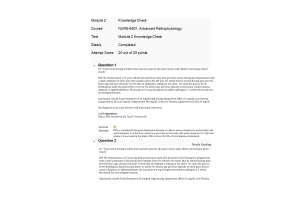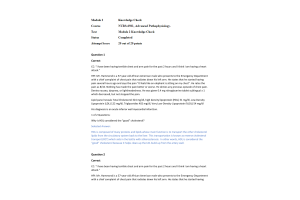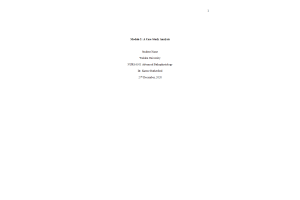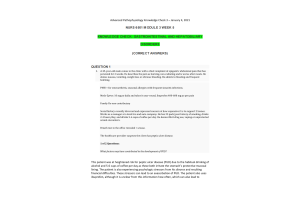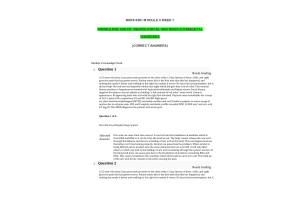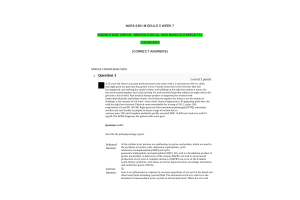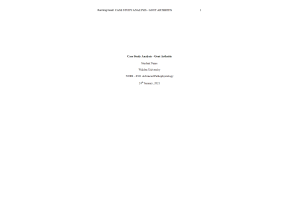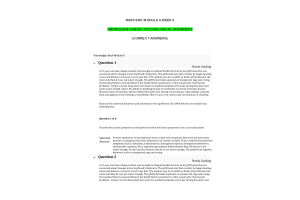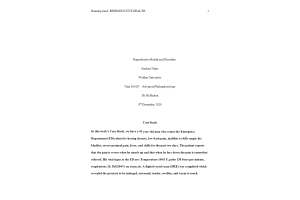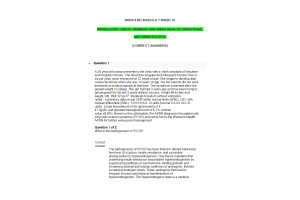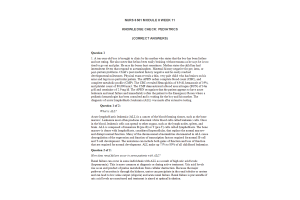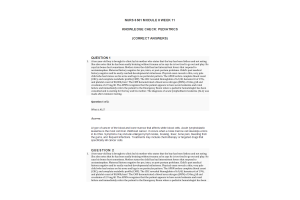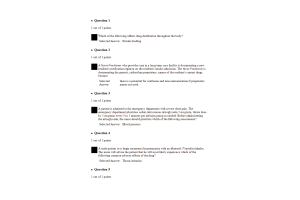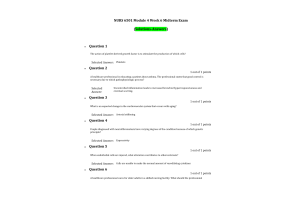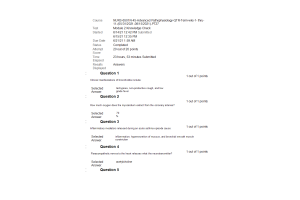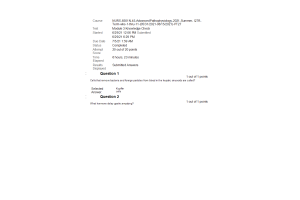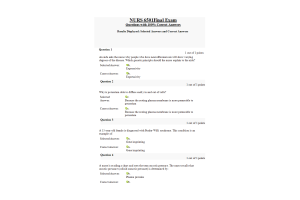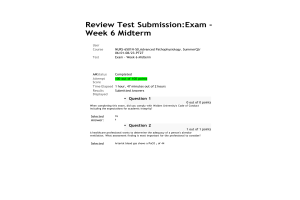NURS 6501 Week 6 Knowledge Check; Endocrine Disorders
- $25.00
- Question: A 67-year-old Caucasian woman was brought to the clinic by her son who stated that his mother had become slightly confused over the past several days. She had been stumbling at home and had fallen once but was able to ambulate with some difficulty. She had no other obvious problems and had been eating and drinking. The son became concerned when she forgot her son’s name, so he thought he better bring her to the clinic.
PMH-Type II diabetes mellitus (DM) with peripheral neuropathy x 20 years. COPD. Depression after death of spouse several months ago
Social/family hx - non contributary except for 30 pack/year history tobacco use.
Meds: Metformin 500 mg po BID, ASA 81 mg po qam, escitalopram (Lexapro) 5 mg po q am started 2 months ago
Labs-CBC WNL; Chem 7- Glucose-92 mg/dl, BUN 18 mg/dl, Creatinine 1.1 mg/dl, Na+120 mmol/L,
K+4.2 mmol/L, CO237 m mol/L, Cl-97 mmol/L.
The APRN refers the patient to the ED and called endocrinology for a consult for diagnosis and management of syndrome of inappropriate antidiuretic hormone (SIADH).
Question: Define SIADH and identify any patient characteristics that may have contributed to the development of SIADH.
- Question: A 43-year-old female presents to the clinic with a chief complaint of fever, chills, nausea and vomiting and weakness. She has been unable to keep any food, liquids or medications down. The symptoms began 3 days ago and have not responded to ibuprofen, acetaminophen, or Nyquil when she tried to take them. The temperature has reached as high as 102˚F.
Allergies: none known to drugs or food or environmental
Medications-20 mg prednisone po qd, omeprazole 10 po qam
PMH-significant for 20-year history of steroid dependent rheumatoid arthritis (RA). GERD. No other significant illnesses or surgeries.
Social-denies alcohol, illicit drugs, vaping, tobacco use
Physical exam
Thin, ill appearing woman who is sitting in exam room chair as she said she was too weak to climb on the exam table. VS Temp 101.2˚F, BP 98/64, pulse 110, Resp 16, PaO2 96% on room air.
ROS negative other than GI symptoms.
Based on the patient’s clinical presentation, the APRN diagnoses the patient as having secondary hypocortisolism due to the lack of prednisone the patient was taking for her RA secondary to vomiting.
Question: Explain why the patient exhibited these symptoms?
- Question: A 64-year-old Caucasian female presents to the clinic with vague symptoms of non- specific abdominal pain, myalgias, constipation, polyuria, and says she feels “fuzzy headed” much of the time. She had about of kidney stones a few weeks ago and she fortunately was able to pass the small stones without requiring lithotripsy or other interventions. She was told by the urologist to follow up with her primary care provider after the kidney stones has resolved.
The APRN examining the patient orders a Chem 7 which revealed a serum Ca++ of 13.1 mg/dl. The APN believes the patient has primary hyperparathyroidism and refers the patient to an endocrinologist who does a complete work up and concurs with the APRN’s diagnosis.
Question: What is the role of parathyroid hormone in the development of primary hyperparathyroidism?
- Question: A 64-year-old Caucasian female presents to the clinic with vague symptoms of non- specific abdominal pain, myalgias, constipation, polyuria, and says she feels “fuzzy headed” much of the time. She had a fracture of her right metatarsal without trauma and currently is wearing a walking boot. She also had a bout of kidney stones a few weeks ago and she fortunately was able to pass the small stones without requiring lithotripsy or other interventions. She was told by the urologist to follow up with her primary care provider after the kidney stones has resolved.
The APRN examining the patient orders a Chem 12 which revealed a serum Ca++ of 13.1 mg/dl. The APRN believes the patient has primary hyperparathyroidism and refers the patient to an endocrinologist who does a complete work up and concurs with the APRN’s diagnosis.
Question: Explain the processes involved in the formation of renal stones in patients with hyperparathyroidism.
- Question: A 64-year-old Caucasian female presents to the clinic with vague symptoms of non- specific abdominal pain, myalgias, constipation, polyuria, and says she feels “fuzzy headed” much of the time. She had a fracture of her right metatarsal without trauma and currently is wearing a walking boot. She also had a bout of kidney stones a few weeks ago and she fortunately was able to pass the small stones without requiring lithotripsy or other interventions. She was told by the urologist to follow up with her primary care provider after the kidney stones has resolved.
The APRN examining the patient orders a Chem 12 which revealed a serum Ca++ of 13.1 mg/dl. The APRN believes the patient has primary hyperparathyroidism and refers the patient to an endocrinologist who does a complete work up and concurs with the APRN’s diagnosis.
Question: Explain how a patient with hyperparathyroidism is at risk for bone fractures.
- Question: A 64-year-old Caucasian female who is 4 weeks status post total parathyroidectomy with forearm gland insertion presents to the general surgeon for her post-operative checkup. She states that her mouth feels numb and she feels “tingly all over. The surgeon suspects the patient has hypoparathyroidism secondary to the parathyroidectomy with delayed vascularization of the implanted gland. She orders a Chem 20 to determine what electrolyte abnormalities may be present. The labs reveal a serum Ca++ of 7.1 mg/dl (normal 8.5 mg/dl-10.5 mg/dl) and phosphorous level of 5.6 mg/dl (normal 2.4-4.1 mg/dl).
Question: What serious consequences of hypoparathyroidism occur and why?
- Question: A 17-year-old boy is brought to the pediatrician’s office by his parents who are concerned about their son’s weight loss despite eating more, frequent urination, unquenchable thirst, and fatigue that is interfering with his school/work activities. He had been seemingly healthy until about 3 months ago when his parents started noticing these symptoms but put these symptoms down to his busy schedule including a part time job. He admits to sleeping more and tires very easily. He denies any other symptoms.
PMH-noncontributory. No surgeries or major medical problems. Usual colds and ear infections as a child
Allergies-none know
Family history- maternal uncle with “some kind of sugar diabetes problem” but parents unclear on the exact disease process
Social-denies alcohol, tobacco or illicit drug use. Not sexually active. Junior at local high school and works in a fast food store after school and on weekends.
Labs in office: random glucose 220 mg/dl.
Based on his symptoms and the glucose level, the pediatrician makes a tentative diagnosis of Diabetes Mellitus type 1 and refers the boy and his parents to an endocrinologist for further work up and management plan.
Question: The patient exhibited classic signs of Type 1 diabetes. Explain the pathophysiology of “polydipsia.”
- Question: A 17-year-old boy is brought to the pediatrician’s office by his parents who are concerned about their son’s weight loss despite eating more, frequent urination, unquenchable thirst, and fatigue that is interfering with his school/work activities. He had been seemingly healthy until about 3 months ago when his parents started noticing these symptoms but put these symptoms down to his busy schedule including a part time job. He admits to sleeping more and tires very easily. He denies any other symptoms.
PMH-noncontributory. No surgeries or major medical problems. Usual colds and ear infections as a child
Allergies-none know
Family history- maternal uncle with “some kind of sugar diabetes problem” but parents unclear on the exact disease process
Social-denies alcohol, tobacco or illicit drug use. Not sexually active. Junior at local high school and works in a fast food store after school and on weekends.
Labs in office: random glucose 220 mg/dl.
Based on his symptoms and the glucose level, the pediatrician makes a tentative diagnosis of Diabetes Mellitus type 1 and refers the boy and his parents to an endocrinologist for further work up and management plan.
Question: The patient exhibited classic signs of Type 1 diabetes. Explain the pathophysiology of “polyuria.”
- Question: A 17-year-old boy is brought to the pediatrician’s office by his parents who are concerned about their son’s weight loss despite eating more, frequent urination, unquenchable thirst, and fatigue that is interfering with his school/work activities. He had been seemingly healthy until about 3 months ago when his parents started noticing these symptoms but put these symptoms down to his busy schedule including a part time job. He admits to sleeping more and tires very easily. He denies any other symptoms.
PMH-noncontributory. No surgeries or major medical problems. Usual colds and ear infections as a child
Allergies-none know
Family history- maternal uncle with “some kind of sugar diabetes problem” but parents unclear on the exact disease process
Social-denies alcohol, tobacco or illicit drug use. Not sexually active. Junior at local high school and works in a fast food store after school and on weekends.
Labs in office: random glucose 220 mg/dl.
Based on his symptoms and the glucose level, the pediatrician makes a tentative diagnosis of Diabetes Mellitus type 1 and refers the boy and his parents to an endocrinologist for further work up and management plan.
Question: The patient exhibited classic signs of Type 1 diabetes. Explain the pathophysiology of “polyphagia.”
- Question: A 17-year-old boy is brought to the pediatrician’s office by his parents who are concerned about their son’s weight loss despite eating more, frequent urination, unquenchable thirst, and fatigue that is interfering with his school/work activities. He had been seemingly healthy until about 3 months ago when his parents started noticing these symptoms but put these symptoms down to his busy schedule including a part time job. He admits to sleeping more and tires very easily. He denies any other symptoms.
PMH-noncontributory. No surgeries or major medical problems. Usual colds and ear infections as a child
Allergies-none know
Family history- maternal uncle with “some kind of sugar diabetes problem” but parents unclear on the exact disease process
Social-denies alcohol, tobacco or illicit drug use. Not sexually active. Junior at local high school and works in a fast food store after school and on weekends.
Labs in office: random glucose 220 mg/dl.
Based on his symptoms and the glucose level, the pediatrician makes a tentative diagnosis of Diabetes Mellitus type 1 and refers the boy and his parents to an endocrinologist for further work up and management plan.
Question: The patient exhibited classic signs of Type 1 diabetes. Explain the pathophysiology of “weight loss.”
- Question: A 17-year-old boy is brought to the pediatrician’s office by his parents who are concerned about their son’s weight loss despite eating more, frequent urination, unquenchable thirst, and fatigue that is interfering with his school/work activities. He had been seemingly healthy until about 3 months ago when his parents started noticing these symptoms but put these symptoms down to his busy schedule including a part time job. He admits to sleeping more and tires very easily. He denies any other symptoms.
PMH-noncontributory. No surgeries or major medical problems. Usual colds and ear infections as a child
Allergies-none know
Family history- maternal uncle with “some kind of sugar diabetes problem” but parents unclear on the exact disease process
Social-denies alcohol, tobacco or illicit drug use. Not sexually active. Junior at local high school and works in a fast food store after school and on weekends.
Labs in office: random glucose 220 mg/dl.
Based on his symptoms and the glucose level, the pediatrician makes a tentative diagnosis of Diabetes Mellitus type 1 and refers the boy and his parents to an endocrinologist for further work up and management plan.
Question: The patient exhibited classic signs of Type 1 diabetes. Explain the pathophysiology of “fatigue.”
- Question: A 17-year-old boy is brought to the pediatrician’s office by his parents who are concerned about their son’s weight loss despite eating more, frequent urination, unquenchable thirst, and fatigue that is interfering with his school/work activities. He had been seemingly healthy until about 3 months ago when his parents started noticing these symptoms but put these symptoms down to his busy schedule including a part time job. He admits to sleeping more and tires very easily. He denies any other symptoms.
PMH-noncontributory. No surgeries or major medical problems. Usual colds and ear infections as a child
Allergies-none know
Family history- maternal uncle with “some kind of sugar diabetes problem” but parents unclear on the exact disease process
Social-denies alcohol, tobacco or illicit drug use. Not sexually active. Junior at local high school and works in a fast-food store after school and on weekends.
Labs in office: random glucose 220 mg/dl.
Based on his symptoms and the glucose level, the pediatrician makes a tentative diagnosis of Diabetes Mellitus type 1 and refers the boy and his parents to an endocrinologist for further work up and management plan.
Question: How do genetics and environmental factors contribute to the development of Type 1 diabetes?
- Question: A 17-year-old boy recently diagnosed with Type I diabetes is brought to the pediatrician’s office by his parents with a chief complaint of “having the flu”. His symptoms began 2 days ago, and he has vomited several times and has not eaten very much. He can’t remember if he took his prescribed insulin for several days because he felt so sick. Random glucose in the office reveals glucose 560 mg/dl and the pediatrician made arrangements for the patient to be admitted to the hospitalist service with an endocrinology consult.
BP 124/80mmHg; HR 122bpm; Respirations 32 breaths/min; Temp 97.2˚F; PaO297% on RA
Admission labs: Hgb 14.6 g/dl; Hct 58%
CMP- Na+ 122mmol/L; K+ 5.3mmol/L; Glucose 560mg/dl; BUN 52mg/dl; Creatinine 4.9mg/dl;
Cl- 95mmol/L; Ca++ 8.8mmol/L; AST (SGOT) 248U/L; ALT 198U/L; CK 34/35 IU/L; Cholesterol 198mg/dl;
Phosphorus 6.8mg/dl; Acetone Moderate; LDH38U/L; Alkaline Phosphatase 132U/L.
Arterial blood gas values were as follows: pH 7.09; Paco220mm Hg; Po2100mm Hg; Sao2 98% (room air)
HCO3-7.5mmol/L; anion gap 19.4
A diagnosis of diabetic ketoacidosis was made, and the patient was transferred to the Intensive Care Unit (ICU) for close monitoring.
Question:
The hormones involved in intermediary metabolism, exclusive of insulin, that can participate in the development of diabetic ketoacidosis (DKA) are epinephrine, glucagon, cortisol, growth hormone. Describe how they participate in the development of DKA.
- Question: A 67-year-old African American male presents to the clinic with a chief complaint that he has to “go to the bathroom all the time and I feel really weak.” He states that this has been going on for about 3 days but couldn’t come to the clinic sooner as he went to the Wound Care clinic for a dressing change to his right great toe that has been chronically infected, and he now has osteomyelitis. Patient with known Type II diabetes with poor control. His last HgA1C was 10.2 %. He says he can’t afford the insulin he was prescribed and only takes half of the oral agent he was prescribed. Random glucose in the office revealed glucose of 890 mg/dl. He was immediately referred to the ED by the APRN for evaluation of suspected hyperosmolar hyperglycemic non ketotic syndrome (HHNKS). Also called hyperglycemic hyperosmolar state (HHS).
Question: Explain the underlying processes that lead to HHNKS or HHS.
- Question: A 32-year-old woman presented to the clinic complaining of weight gain, swelling in her legs and ankles and a puffy face. She also recently developed hypertension and diabetes type 2. She noted poor short-term memory, irritability, excess hair growth (women), red-ruddy face, extra fat around her neck, fatigue, poor concentration, and menstrual irregularity in addition to muscle weakness. Given her physical appearance and history, a tentative diagnosis of hypercortical function was made. Diagnostics included serum and urinary cortisol and serum adrenocorticotropic hormone (ACTH). MRI revealed a pituitary adenoma.
Question: How would you differentiate Cushing’s disease from Cushing’s syndrome?
- Question: A 47-year-old female is referred to the endocrinologist for evaluation of her chronically elevated blood pressure, hypokalemia, and hypervolemia. The patient’s hypertension has been refractory to the usual medications such as beta blockers, diuretics, and angiotensin-converting enzyme (ACE) inhibitors. After a full work up including serum and urinary electrolyte levels, aldosterone suppression test, plasma aldosterone to renin ratio, and MRI which revealed an autonomous adenoma, the endocrinologist diagnoses the patient with primary hyper-aldosteronism.
Question: What is the pathogenesis of primary hyper-aldosteronism?
- Question: A 47-year-old African American male presents to the clinic with chief complaints of polyuria, polydipsia, polyphagia, and weight loss. He also said that his vison occasionally blurs and that his feet sometimes feel numb. He has increased hunger despite weight loss and admits to feeling unusually tired. He also complains of “swelling” and enlargement of his abdomen.
Past Medical History (PMH) significant for HTN fairly well controlled with and ACE inhibitor; central obesity, and dyslipidemia treated with a statin, Review of systems negative except for chief complaint. Physical exam unremarkable except for decreased filament test both feet. Random glucose in office 290 mg/dl. The APRN diagnoses the patient with type II DM and prescribes oral medication to control the glucose level and also referred the patient to a dietician for dietary teaching.
Question: What is the basic underlying pathophysiology of Type II DM?
- Question: A 21-year-old male was involved in a motorcycle accident and sustained a closed head injury. He is waking up and interacting with his family and medical team. He complained of thirst that doesn’t seem to go away no matter how much water he drinks. The nurses note that he has had 3500 cc of pale-yellow urine in the last 24 hours. Urine was sent for osmolality which was reported as 122 mOsm/L. A diagnosis of probable neurogenic diabetes insipidus was made.
Question: What causes diabetes insipidus (DI)?
- Question: A 43-year-old female patient presents to the clinic with complaints of nervousness, racing heartbeat, anxiety, increased perspiration, heat intolerance, hyperactivity and palpitations. She states she had had the symptoms for several months but attributed the symptoms to beginning to care for her elderly mother who has Alzheimer’s Disease. She has lost 15 pounds in the last 3 months without dieting. Her past medical history is significant for rheumatoid arthritis that she has had for the last 10 years well controlled with methotrexate and prednisone. Physical exam is remarkable for periorbital edema, warm silky feeling skin, and palpable thyroid nodules in both lobes of the thyroid. Pending laboratory diagnostics, the APRN diagnoses the patient as having hyperthyroidism, also called Graves’ Disease.
Question: Explain how the negative feedback loop controls thyroid levels.
- Question: A 43-year-old female patient with known Graves’ Disease presents to the clinic with complaints of nervousness, racing heartbeat, anxiety, increased perspiration, heat intolerance, hyperactivity and severe palpitations. She states she had been given a prescription for propylthiouracil, an antithyroid medication but she did not fill the prescription as she claims she lost it. She had been given the option of thyroidectomy which she declined. She also notes that she is having trouble with her vision and often has blurry eyes. She states that her eyes seem “to bug out of her face”. She has had recurrent outs of nausea and vomiting. She was recently hospitalized for pneumonia. Physical exam is significant for obvious exophthalmos and pretibial myxedema. Vital signs are temp 101.2˚F, HR 138 and irregular, BP 160/60 mmHg. Respirations 24. Electrocardiogram revealed atrial fibrillation with rapid ventricular response. The APRN recognizes the patient is experiencing symptoms of thyrotoxic crisis, also called thyroid storm. The patient was immediately transported to a hospital for critical care management.
Question: How did the patient develop thyroid storm? What were the patient factors that lead to the development of thyroid storm?
- Question: A 44-year-old woman presents to the clinic with complaints of extreme fatigue, weight gain, decreased appetite, cold intolerance, dry skin, hair loss, and sleepiness. She also admits that she often bursts into tears without any reason and has been exceptionally forgetful. Her vision is occasionally blurry, and she admits to being depressed without any social or occupational triggers. Past medical history noncontributory. Physical exam Temp 96.2˚F, pulse 62 and regular, BP 108/90, respirations. Dull facial expression with coarse facial features. Periorbital puffiness noted. Based on the clinical history and physical exam, and pending laboratory data, the ARNP diagnoses the patient with hypothyroidism.
Question: What causes hypothyroidism?
- Question: A 44-year-old woman is brought to the clinic by her husband who says his wife has had some mental status changes over the past few days. The patient had been previously diagnosed with hypothyroidism and had been placed on thyroid replacement therapy but had been lost to follow-up due to moving to another city for the husband’s work approximately 4 months ago. The patient states she lost the prescription bottle during the move and didn’t bother to have the prescription filled since she was feeling better. Physical exam revealed non-pitting, boggy edema around her eyes, hands and feet as well as the supraclavicular area. The APRN recognizes this patient had severe myxedema and referred the patient to the hospital for medical management.
Question: What causes myxedema coma?
- Question: A 53-year-old woman presents to the primary care clinic with complaints of severe headaches, palpitations, high blood pressure and diaphoresis. She relates that these symptoms come in clusters and when she has these “spells”, she also experiences, tremor, nausea, weakness, anxiety, and a sense of doom and dread, epigastric pain, and flank pain. She had one of these spells when she was at the pharmacy and the pharmacist took her blood pressure which was recorded as 200/118. The pharmacist recommended that she immediately be evaluated for these symptoms. Past medical history significant for a family history of neurofibromatosis type 1 (NF1). Based on the presenting symptoms and family history of NF1, the APRN suspects the patient has a pheochromocytoma. Laboratory data and computerized tomography of the abdomen confirms the diagnosis.
Question: What is a pheochromocytoma and how does it cause the classic symptoms the patient presented with?
- Question: A 53-year-old woman presents to the primary care clinic with complaints of severe headaches, palpitations, high blood pressure and diaphoresis. She relates that these symptoms come in clusters and when she has these “spells”, she also experiences, tremor, nausea, weakness, anxiety, and a sense of doom and dread, epigastric pain, and flank pain. She had one of these spells when she was at the pharmacy and the pharmacist took her blood pressure which was recorded as 200/118. The pharmacist recommended that she immediately be evaluated for these symptoms. Past medical history significant for a family history of neurofibromatosis type 1 (NF1). Based on the presenting symptoms and family history of NF1, the APRN suspects the patient has a pheochromocytoma. Laboratory data and computerized tomography of the abdomen confirms the diagnosis.
Question: What are the treatment goals for managing pheochromocytoma?
